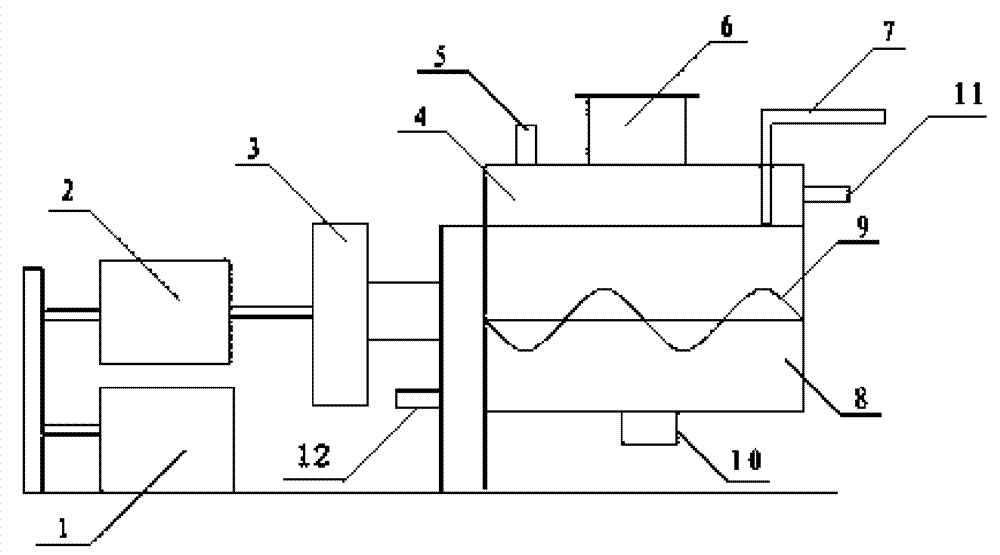Technique for producing stearate by dry method and device
A technology of stearate and production process, which is applied in the direction of carboxylate preparation, chemical/physical/physicochemical fixed reactor, organic chemistry, etc., can solve the problem of excessive COD and suspended solids in wastewater, increasing the pressure of wastewater treatment and Pollution control costs and other issues, to achieve the effect of improving production efficiency, shortening production cycle, and complete response
- Summary
- Abstract
- Description
- Claims
- Application Information
AI Technical Summary
Problems solved by technology
Method used
Image
Examples
Embodiment 1
[0023] Embodiment 1: Reaction raw material: 48 kilograms of calcium hydroxide, 352 kilograms of stearic acid, 15 kilograms of deionized water.
[0024] First put stearic acid into the reaction vessel 4 through the feeding port 6, heat and stir for about 10 minutes, after the temperature rises to 50°C, put calcium hydroxide into it, and after fully stirring, pour 15kg of deionized water from the feeding port, and pass The gas inlet and outlet pipeline port 7 is continuously fed with nitrogen, and the air in the reaction vessel 4 is discharged from the top feed inlet 6. After gradually replacing the air in the reaction vessel 4 with nitrogen, the feed inlet 6 and the gas inlet and outlet pipeline mouth 7 valves are closed tightly. While stirring, gradually heat the reaction mass to between 80°C and 120°C. Keep the vapor pressure formed by the deionized water and the reaction water in the reaction vessel 4 between 0 and 0.1 MPa. After reacting for about two hours, open the valve...
Embodiment 2
[0025] Embodiment 2: Reaction raw materials: 30 kilograms of calcium oxide, 285 kilograms of stearic acid, 12 kilograms of deionized water.
[0026] First, calcium oxide is put into the reaction vessel 4 through the feeding port 6, stirred and added with deionized water, after the calcium oxide and water react completely, stearic acid is put in, and nitrogen gas is continuously introduced through the gas inlet and outlet pipe port 7, and the reactor 4 The air is discharged from the top feeding port 6, and after gradually replacing the air in the reactor 4 with nitrogen, close the feeding port 6 and the gas inlet and outlet pipe port 7 valves. While stirring, gradually heat the reaction mass to between 80°C and 120°C. Keep the vapor pressure formed by the deionized water and the reaction water in the reactor 4 between 0-0.1 MPa. After reacting for about two hours, open the valve of the gas inlet and outlet pipeline 7, and discharge the nitrogen, deionized water vapor and the w...
Embodiment 3
[0027] Embodiment 3: Reaction raw materials: 49.5 kilograms of zinc oxide, 330 kilograms of stearic acid, 15 kilograms of deionized water.
[0028] First, zinc oxide is put into the reaction vessel 4 through the feeding port 6, stirred and added with deionized water, after the reaction between the zinc oxide and water is completed, stearic acid is put in, and nitrogen gas is continuously fed through the gas inlet and outlet pipe port 7, and the reactor 4 The air is discharged from the top feeding port 6, and after gradually replacing the air in the reactor 4 with nitrogen, close the feeding port 6 and the gas inlet and outlet pipe port 7 valves. While stirring, gradually heat the reaction mass to between 80°C and 110°C. Keep the vapor pressure formed by the deionized water and the reaction water in the reactor 4 between 0-0.1 MPa. After reacting for about two hours, open the valve of the gas inlet and outlet pipeline 7, and discharge the nitrogen, deionized water vapor and th...
PUM
 Login to View More
Login to View More Abstract
Description
Claims
Application Information
 Login to View More
Login to View More - R&D
- Intellectual Property
- Life Sciences
- Materials
- Tech Scout
- Unparalleled Data Quality
- Higher Quality Content
- 60% Fewer Hallucinations
Browse by: Latest US Patents, China's latest patents, Technical Efficacy Thesaurus, Application Domain, Technology Topic, Popular Technical Reports.
© 2025 PatSnap. All rights reserved.Legal|Privacy policy|Modern Slavery Act Transparency Statement|Sitemap|About US| Contact US: help@patsnap.com


